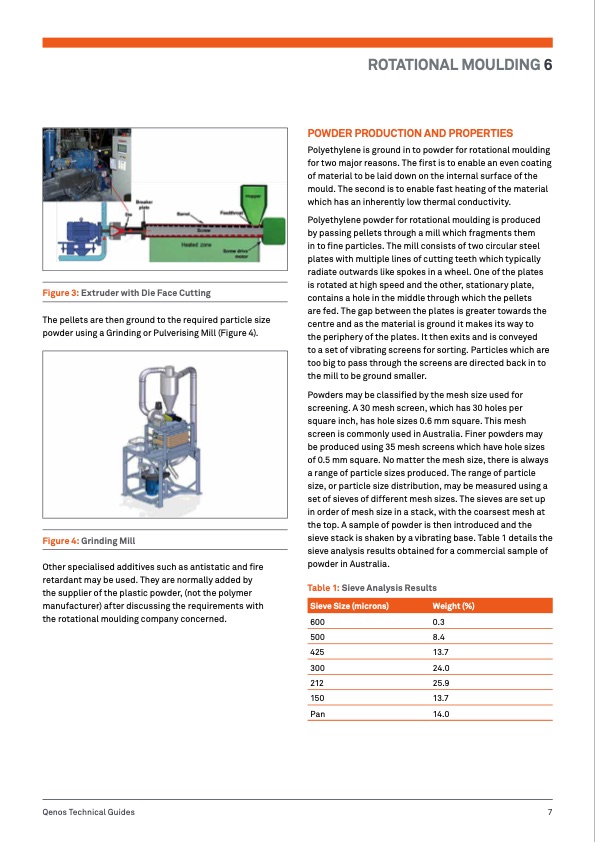
PDF Publication Title:
Text from PDF Page: 009
Figure 3: Extruder with Die Face Cutting The pellets are then ground to the required particle size powder using a Grinding or Pulverising Mill (Figure 4). ROTATIONAL MOULDING 6 POWDER PRODUCTION AND PROPERTIES Polyethylene is ground in to powder for rotational moulding for two major reasons. The first is to enable an even coating of material to be laid down on the internal surface of the mould. The second is to enable fast heating of the material which has an inherently low thermal conductivity. Polyethylene powder for rotational moulding is produced by passing pellets through a mill which fragments them in to fine particles. The mill consists of two circular steel plates with multiple lines of cutting teeth which typically radiate outwards like spokes in a wheel. One of the plates is rotated at high speed and the other, stationary plate, contains a hole in the middle through which the pellets are fed. The gap between the plates is greater towards the centre and as the material is ground it makes its way to the periphery of the plates. It then exits and is conveyed to a set of vibrating screens for sorting. Particles which are too big to pass through the screens are directed back in to the mill to be ground smaller. Powders may be classified by the mesh size used for screening. A 30 mesh screen, which has 30 holes per square inch, has hole sizes 0.6 mm square. This mesh screen is commonly used in Australia. Finer powders may be produced using 35 mesh screens which have hole sizes of 0.5 mm square. No matter the mesh size, there is always a range of particle sizes produced. The range of particle size, or particle size distribution, may be measured using a set of sieves of different mesh sizes. The sieves are set up in order of mesh size in a stack, with the coarsest mesh at the top. A sample of powder is then introduced and the sieve stack is shaken by a vibrating base. Table 1 details the sieve analysis results obtained for a commercial sample of powder in Australia. Table 1: Sieve Analysis Results 600 0.3 500 8.4 425 13.7 300 24.0 212 25.9 150 13.7 Pan 14.0 Figure 4: Grinding Mill Other specialised additives such as antistatic and fire retardant may be used. They are normally added by the supplier of the plastic powder, (not the polymer manufacturer) after discussing the requirements with the rotational moulding company concerned. Sieve Size (microns) Weight (%) Qenos Technical Guides 7PDF Image | ROTATIONAL MOULDING Guide

PDF Search Title:
ROTATIONAL MOULDING GuideOriginal File Name Searched:
TG6Roto.pdfDIY PDF Search: Google It | Yahoo | Bing
Development of a solar powered Electric Ship The Electricship website originally started off as a project to develop a comprehensive renewable, affordable, modular electric ship... More Info
Modular Boat Hull Composite The case for a unsinkable, modular composite hybrid boat hull... More Info
MS Burgenstock Hybrid Electric Catamaran Lake Lucerne Unique shuttle servicing Lucerne to the Burgenstock Resort... More Info
Ground Power Unit GPU Powered by Lithium Ion Batteries The goal of the Ground Power Unit is to provide a readily accessible, modular, ready-to-power solution for remote power... More Info
| CONTACT TEL: 608-238-6001 Email: greg@electricship.com | RSS | AMP |